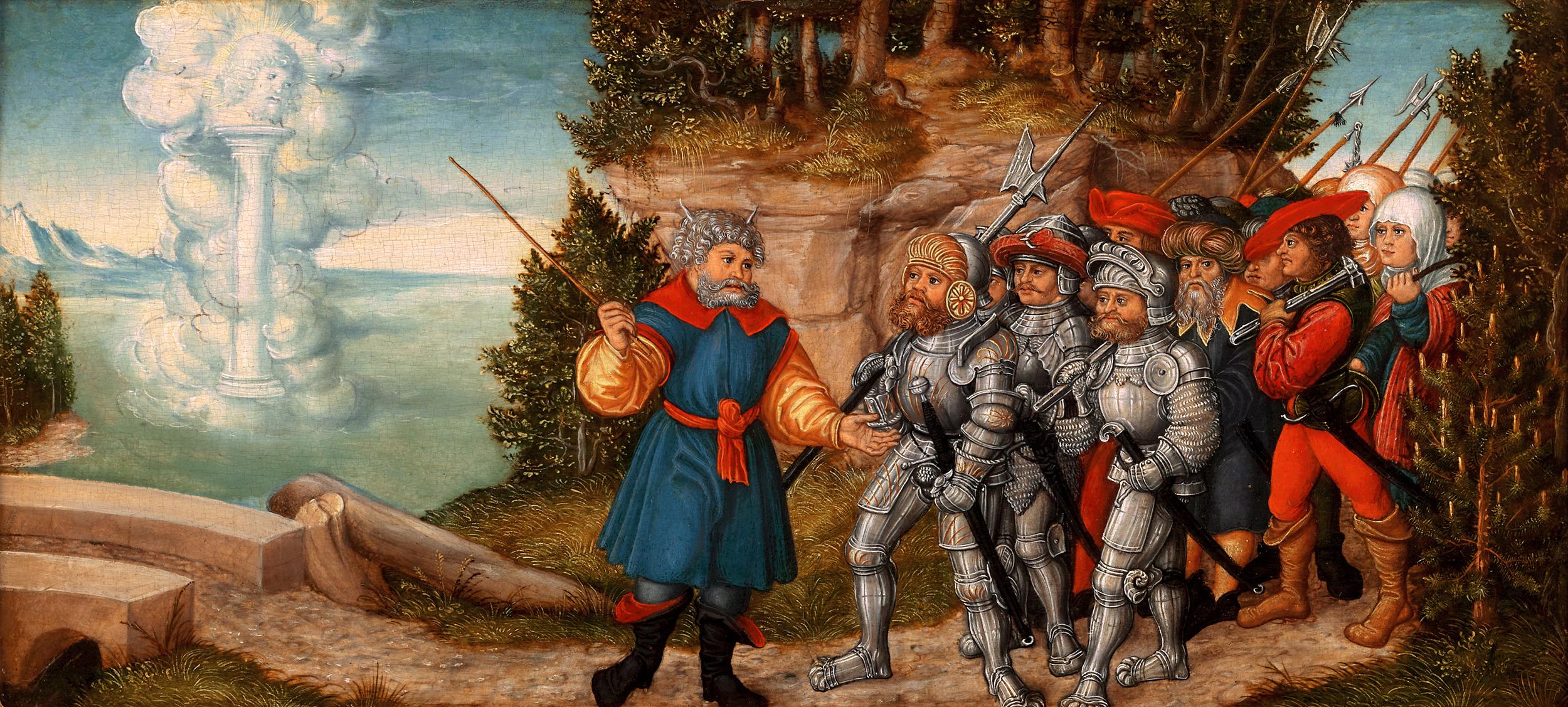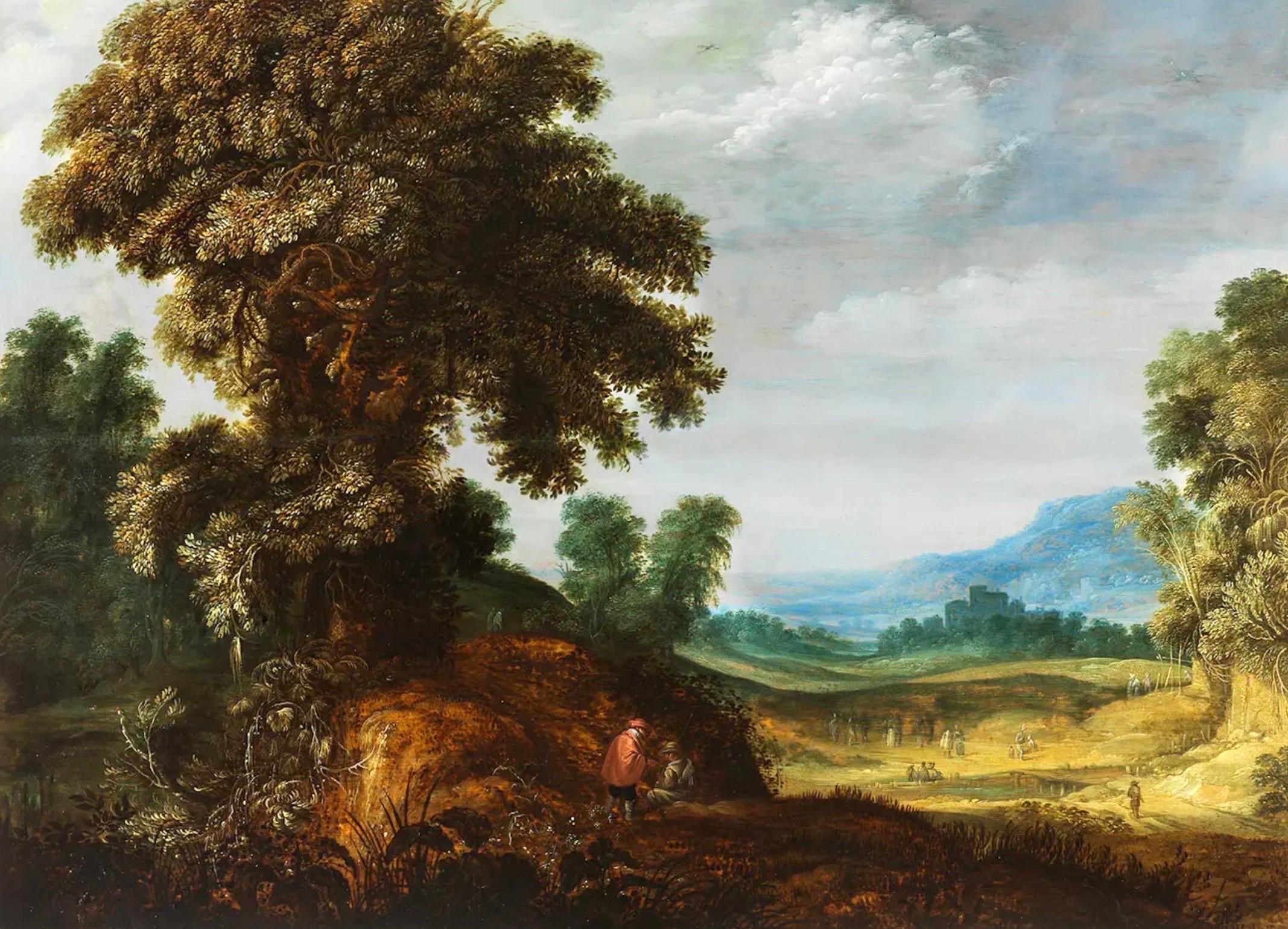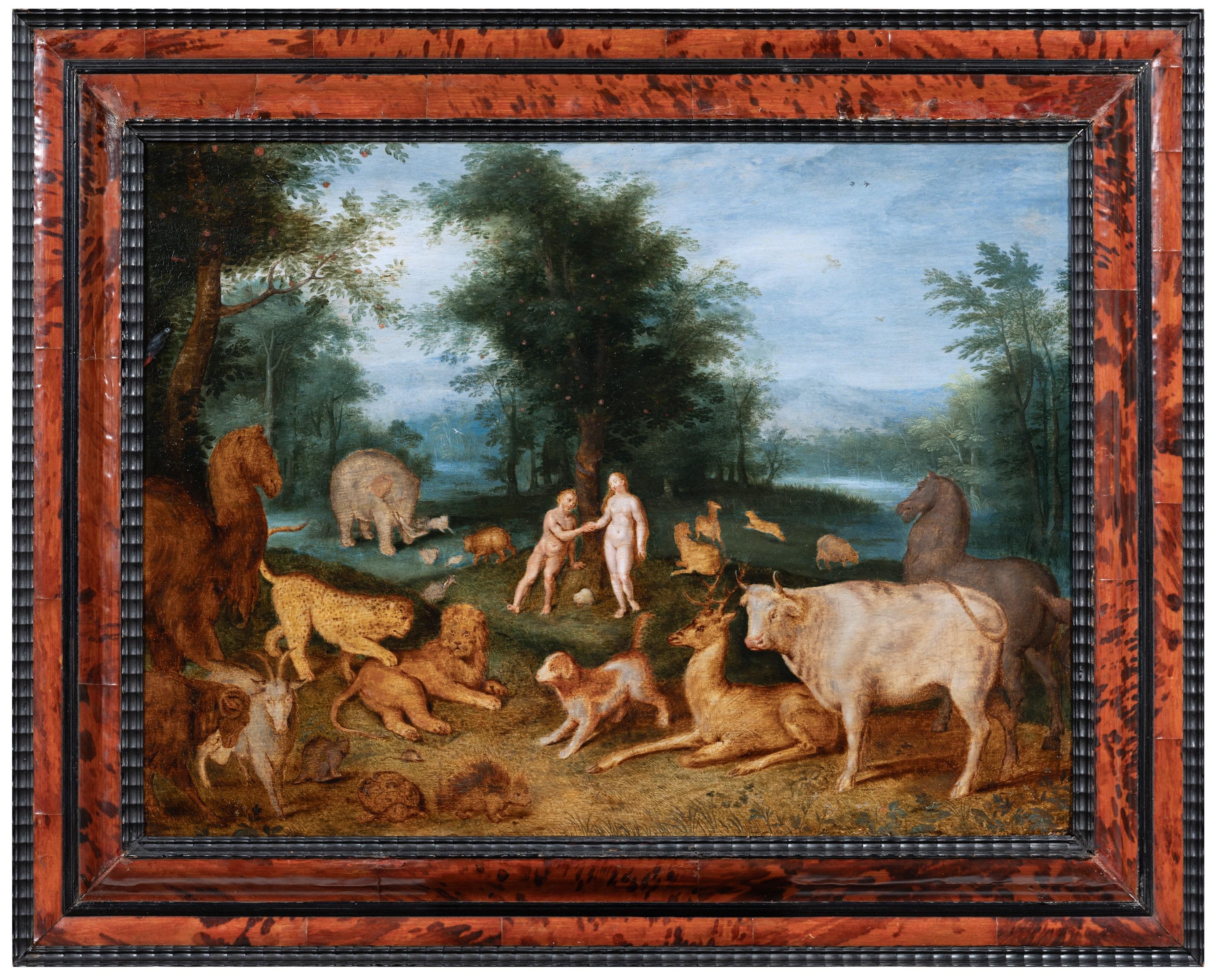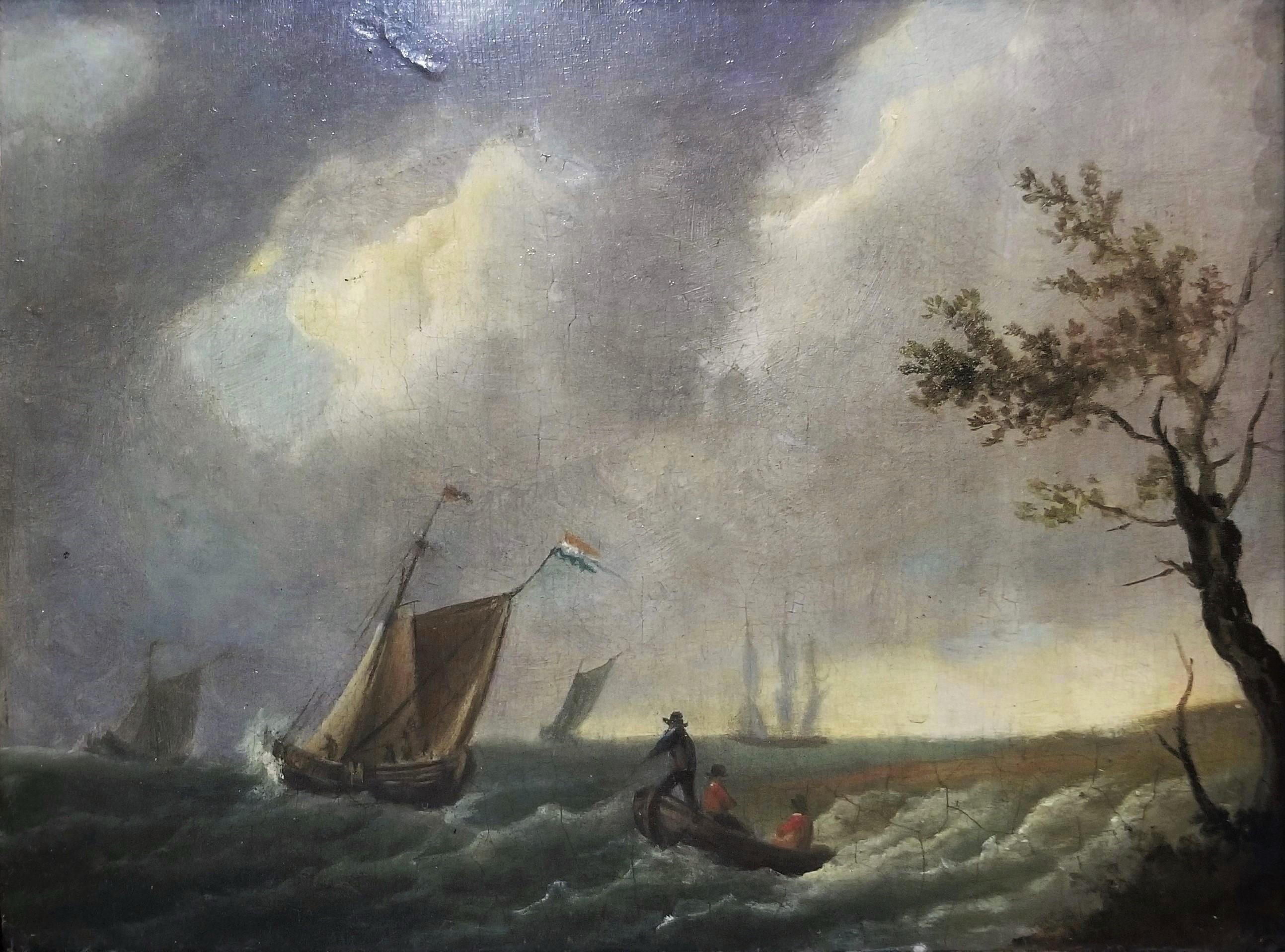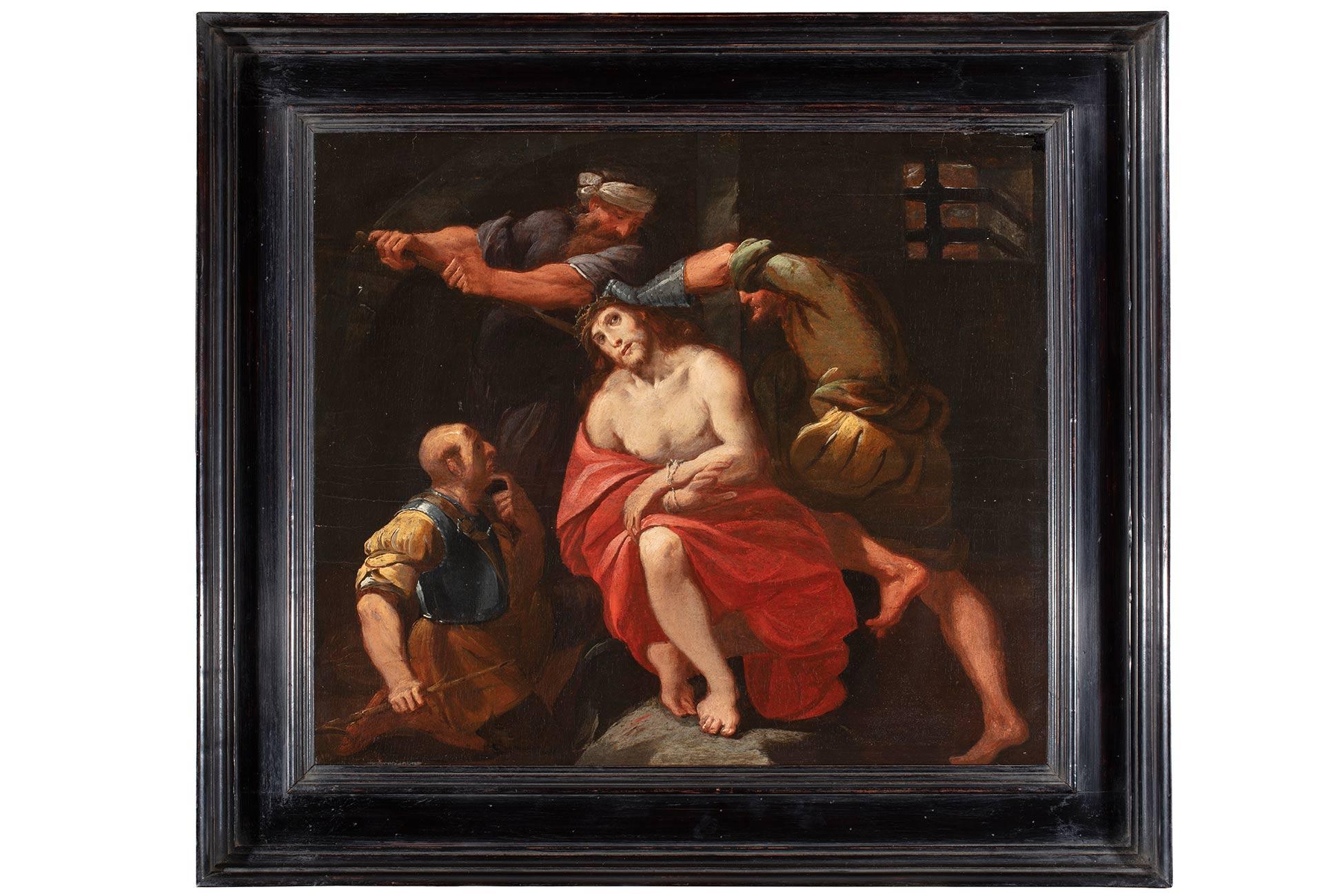Items Similar to River Landscape with a Windmill and Chapel
Want more images or videos?
Request additional images or videos from the seller
1 of 13
Jan Josefsz Van GoyenRiver Landscape with a Windmill and Chapelc. 1644
c. 1644
About the Item
"River Landscape with a Windmill and Chapel" is a painting by Dutch Old Master Painter, Jan van Goyen. There are traces of a signature on the bow of the boat in the right foreground. The framed piece measures 32 1/2 x 41 3/4 x 2 1/4 in.
Jan van Goyen came of age at a most propitious time. Born in 1596 and several generations after the Protestant Reformation that created a market for secularized art, he prospered as an artist specializing in the landscape. He would achieve great fame, his paintings synonymous with collectability and status. Indeed, mid-and-late seventeenth-century inventories of Dutch Republic households reveal that Van Goyen was represented in their collections more often than any other artist of the time; his paintings prized by people with neither great wealth nor exceptional connoisseurship as well as those who owned uncommonly fine paintings by Rembrandt, Hals, or Dou. Van Goyen is a key figure in the emergence of modern art commerce. But more importantly, he was a trendsetter who established a new aesthetic that dominated much of Dutch and Flemish landscape painting during much of the century labeled, ‘The Golden Age.’
This new aesthetic, a sober, sepia-toned palette bound by an underlying ochre ground is the stylistic mannerism for which Van Goyen’s is most known. He continued to accept commissions in the colorful manner of his earlier work in the manner of his teacher, Esaias van de Velde but the atmospheric, honeyed impression of River Landscape with a Windmill and Chapel is emblematic of his mature style. The style was employed by many artists of his generation (including still life and genre painters), but Van Goyen applied this palette and technique in the extreme throughout the 1630s and 1640s. It is a tack that facilitated rapid wet-on-wet application of paint that could accelerate the pace of production, address the demands of a burgeoning market, and reduce material costs. Yet whatever economic motivation that prompted Van Goyen to adopt the technique, no artist of the time displayed more virtuosity with a loaded brush or achieved more fame because of it. As Samuel van Joogstraeten related in his 1678 treatise on the art of painting, during a competition held around 1630, three landscapists were challenged to create a painting in a single day, and it was Van Goyen who displayed an effortless ability to conjure up a range of motifs out of nothing. ‘By “swaddling” the whole panel all at once — here light, there dark, more or less like a multicolor agate, or marbled paper — he (Van Goyen) was able, with barely any effort, to apply with tiny brushstrokes all manner of drolleries, so that over yonder a distant view looms up with peasant hamlets, while elsewhere appears an old fort with a gate and landing stage reflected in the rippling water, as well as various kinds of ships and barges, loaded with passengers and freight. In short, his eye — as though in search of the forms that lay hidden in the chaos of his painting — skillfully guided his hand, so that one saw a perfect painting.’ (Judikje Kiers, The Golden Age of Dutch Art, pg. 133)
River Landscape with a Windmill and Chapel offers several insights into key characteristics of technique and mannerisms that shape our appreciation for the so-called ‘Golden Age’; a low vantage point so that the eye of the viewer is at the height of the figures and setting, a generous expanse of a sky and clouds, and a fantastic sense of distancing and perspective. Van Goyen painted many views such as this, based on graphite, charcoal, or ink sketches while engaging in careful study of the formal elements near Dordrecht, Nijmegen, Rhenen, or Arnhem during the 1630s and until 1641. Between 1641 and 1651, he produced views such as this along a river, especially at Nijmegen, and as depicted in Castle by a River (Metropolitan Museum of Art) of 1647. In any event, given Van Goyen’s remarkable talent for extemporizing, changing, and shifting architectural elements, his work provides endless possibilities and remarkable variation.
Provenance:
Victor Phaland, Wesel, Germany
His Sale: Frederik Muller & Co., Amsterdam, April 24, 1906, no. 76, illus., as with traces of a signature
Gaston Neumans, 1906
F. Hartman, Norway
Sale: Sotheby's New York, June 5, 1986, Old Masters Paintings, sale 5471, lot 0051
Private Collection, New York
Private Collection, California, by descent
Literature:
G. Hofstede de Groot, Catalogue Raisonne of the Works of the most Eminent Dutch Painters, 1927, Vol. VIII, p. 234, no. 947 (as with traces of a signature)
H. Volhard, Die Grundtypen der Landschagtsbilder Jan van Goyens, 1927, doctoral dissertation, pp. 120 & 179
Hans-Ulrich Beck, Jan van Goyen, 1973, Vol. II, p. 329, no. 724, illus.
- Creator:Jan Josefsz Van Goyen (1596 - 1656, Dutch)
- Creation Year:c. 1644
- Dimensions:Height: 22.5 in (57.15 cm)Width: 31.75 in (80.65 cm)
- Medium:
- Movement & Style:
- Period:1640-1649
- Condition:
- Gallery Location:Palm Desert, CA
- Reference Number:
About the Seller
4.8
Recognized Seller
These prestigious sellers are industry leaders and represent the highest echelon for item quality and design.
Established in 1996
1stDibs seller since 2011
102 sales on 1stDibs
Typical response time: 7 hours
- ShippingRetrieving quote...Ships From: Jackson, WY
- Return PolicyA return for this item may be initiated within 7 days of delivery.
More From This SellerView All
- A Dune Landscape with Figures Resting and a Couple on Horseback, a View of NijmeLocated in Palm Desert, CA"A Dune Landscape with Figures Resting and a Couple on Horseback, a View of Nijmegen Cathedral Beyond" is a painting by Dutch Old Master painter Salomon van Ruysdael...Category
1640s Old Masters Landscape Paintings
MaterialsOil, Canvas
- Evening Mesa and RimLocated in Palm Desert, CA"Evening Mesa and Rim" is an oil on panel work by Duncan Martin. The framed size is 21 x 25 1/4 x 1 inch. Provenance: Private CollectionCategory
21st Century and Contemporary Contemporary Landscape Paintings
MaterialsOil, Panel
- UntitledLocated in Palm Desert, CA"Untitled" is an oil on panel painting by Duncan Martin. The framed size is 17 x 20 7/8 x 1 inch. Provenance: Private CollectionCategory
Late 20th Century Expressionist Landscape Paintings
MaterialsOil, Panel
- Grand Canyon SeriesBy Sheldon ParsonsLocated in Palm Desert, CA"Grand Canyon Series" is an oil on panel painting by Sheldon Orrin Parsons, painted in 1943. The work is signed in the lower left, “Sheldon Parsons 16”...Category
Mid-20th Century American Realist Landscape Paintings
MaterialsOil, Panel
- Navajo CampBy Gerard Curtis DelanoLocated in Palm Desert, CA"Navajo Camp" is an oil on panel painting by Gerard Curtis Delano. The painting is signed lower left "Delano". The framed piece measures 31 x 36 3/4 x 1 7/8 inches. Delano was a pai...Category
Early 20th Century American Realist Landscape Paintings
MaterialsPanel, Oil
- Venetian Boats at Sotto MarinoBy Edgar PayneLocated in Palm Desert, CA"Venetian Boats at Sotto Marino" is a painting by Edgar Alwin Payne. The painting is signed lower left, "Edgar Payne". The framed piece measures 31 1/2 x 34 1/2 x 2 3/4 in. Payne wa...Category
Early 20th Century Tonalist Landscape Paintings
MaterialsOil, Panel
You May Also Like
- Moses and the Pillar of Cloud by Lucas Cranach the Elder and StudioBy Lucas Cranach the ElderLocated in New Orleans, LALucas Cranach the Elder and Studio 1472-1553 German Moses and the Pillar of Cloud Oil on panel Moses and the Pillar of Cloud is a bold and evocative composition that showcases the signature intense color and intricate detail of Lucas Cranach the Elder’s celebrated oeuvre. The remarkable 16th-century oil on panel by Lucas Cranach and his studio captures the narrative moment when Moses leads the Israelites out of Egypt and encounters God manifested through a large pillar of cloud. Moses stands at the precipice of a bridge and turns back to soldiers helping to lead the group of Israelites who huddle closely together. Cranach depicts Moses with his traditional iconography, rendering the rays of light on his head which came to be interpreted as "horns" in the translation of the Bible. Using his traditional walking staff, Moses gestures toward the pillar, seemingly acknowledging that God will protect the group as they cross the bridge to the other side, leaving exile and entering a promised land. In a nod to Cranach’s Germanic locale, he renders the figures and setting in a manner that feels decisively more akin to European aesthetics than those of the Red Sea. Soldiers wear elaborate, gothic suits of armor that recall the livery of Northern European guardsmen. The terrain appears more like a European forest giving way to a sweeping valley than the arid landscape the Israelites trekked through on their journey across the Red Sea. Though still clearly recounting a story from the Old Testament, Cranach renders the cast of characters and setting in an earthly, familiar manner. This aesthetic shift speaks to Cranach’s own changing beliefs as he found himself at the center of the Protestant Reformation. After first gaining recognition in 1505 as the official painter of Frederick the Wise, Cranach established a thriving painting and print studio in Wittenberg, Germany. Cranach was renowned for his court portraits and genre paintings and was also well known for his association with the famous protestant reformer Martin Luther, then under the protection of Frederick the Wise. As Wittenberg became a bastion of new religious thought, Cranach soon befriended Luther and played an active role in creating the printed materials that proliferated throughout the Reformation...Category
16th Century Old Masters Figurative Paintings
MaterialsOil, Panel
- Antique English 19th century marine sceneBy William AndersonLocated in Woodbury, CTOutstanding English late 18th / early 19th century marine scene by one of Britain's best known and sought after painters. William (or Wiliam) Anderson (1757 – 27 May 1837) was a Scottish artist specializing in maritime and patriotic themes. He was well-regarded for his detailed and accurate portraits of ships under sail, exhibiting his works annually in London between 1787 and 1811 and then occasionally until 1834. Anderson influenced other artists, notably John Ward and others of the Hull school. Anderson's early life is obscure, but he is known to have trained as a shipwright before moving to London to become a maritime painter when he was about 30. His training served him well as a painter, providing "a practical nautical knowledge" of his subjects. He earned a reputation for "accuracy and refinement of detail" and was admired for his bright, clear colours. He worked in both oils and watercolours. He based his style on that of well-known Dutch maritime...Category
1810s Old Masters Figurative Paintings
MaterialsOil, Wood Panel
- 17th century Flemish Old Master painting - Vast landscape with a majestic oakLocated in Antwerp, BE17th century Flemish old master painting depicting a forest landscape with a majestic oak Alexander Keirincx, born around 1600 in Antwerp, Belgium, was a prominent Flemish landscape...Category
17th Century Old Masters Landscape Paintings
MaterialsOil, Panel
- Adam and Eve in paradise, studio of Jan Brueghel the Younger, 17th centuryLocated in PARIS, FRStudio of Jan Brueghel the Younger 17th century Antwerp school Oil on oak panel, h. 37 cm, w. 49 cm Tortoiseshell veneered baroque style frame...Category
Mid-17th Century Old Masters Figurative Paintings
MaterialsOil, Wood Panel
- Dutch Fishing Vessels in Storm /// Francis Swaine Maritime Seascape Antique ShipBy Francis SwaineLocated in Saint Augustine, FLArtist: Francis Swaine (English, 1725-1782) Title: "Dutch Fishing Vessels in Storm" *No signature found Circa: 1770 Medium: Original Oil Painting on wood panel Framing: Framed in a Louis XV style gold moulding Framed size: 10.63" x 12.63" Panel size (irregular margins): 6" x 7.75" Condition: One small restored spot upper left. Cosmetic wear to frame. In otherwise very good condition Notes: Provenance: private collection - London, England; acquired from art dealer Ernest Alden, London, England retaining his original gallery label on verso. Metal plaque inscribed "F. Swaine 1740-1782", (active dates), attached to frame bottom center. Ernest William Alden (1866-1947) was recorded in successive censuses, in 1881 as a picture mounter (card maker), age 14, living at 9 Bloomsbury St, with several other members of his family also given as picture mounters, including his father, James; in 1891 as a picture frame mounter with his father and family at 208 Shaftesbury Avenue; in 1901 as a photographer and picture dealer at 39 King’s Road, Chelsea; and in 1911 again at 39 King’s Road but the census form is damaged. His listing in trade directories, initially as picture mount cutter, changed to picture framemaker from 1904, soon after he set up in the King’s Road. He advertised his large stock of second-hand swept and other frames, claiming to have been established in 1893 (The Year’s Art 1913). Alden died in Chelsea in 1947, leaving effects worth £5,011, with probate granted to his widow Lily Alden and to Marjorie Frances Alden. Two of his younger brothers, Henry Cyril Alden (1871-1939) and James Preston Alden (1876-1960), were also active as picture framemakers. - National Portrait Gallery, London, England. Biography: Francis Swaine (1725–1782) was a British marine painter. He was born in 1725, and christened on 7 October of that year at St Dunstan's, Stepney, London. His parents were named Francis Swaine and Ann Joel. In 1735 the elder Francis Swaine, the marine painter's father, applied in writing to the Commissioners of His Majesty's Navy for employment as a Navy Messenger, in succession to Mr William Wyatt. He mentions that he had served "upwards of twenty eight years" in the Navy, and that his father had died Purser of the Royal Katherine. He mentions also that he had carried out "little labours in drawing", and that he at that time had five small children. The first-born of these children was the Francis Swaine who became the marine painter. The elder Swaine was duly employed as a Navy Messenger. He served for 20 years and died on 10 October 1755, aged 64. Swaine is said to have been influenced by the style of Van de Velde. There is no clear evidence of this alleged influence. The suggestion that Swaine may have been a pupil of Charles Brooking...Category
1770s Old Masters Landscape Paintings
MaterialsPaint, Oil, Panel, Wood Panel, Board
- 17th Century by Giovan Battista Discepoli Coronation of Thorns Oil on PanelLocated in Milano, LombardiaGiovan Battista Discepoli, called the Zoppo from Lugano [Castagnola (Lugano) 1590 - Lugano 1654] Coronation of Thorns Oil on panel, cm. 34.2x39.5 – with frame cm. 46x52 Shaped and ...Category
Early 17th Century Old Masters Landscape Paintings
MaterialsOil, Panel
Recently Viewed
View AllMore Ways To Browse
Art Commerce
Impression Landscape Paint
Landscape Art 32 X 32
Fantastic Landscape
Antique Landscape Panel Painting
German River
Flemish Landscape
Norway Landscape
Old Master Style Landscapes
Sepia Landscape
Flemish Landscape Painting
Dutch Landscape Modern
Antique Chapel
Old Hand Saws
Used Windmills
The Windmill
Chapel Oil Paintings
C Hans Paintings
